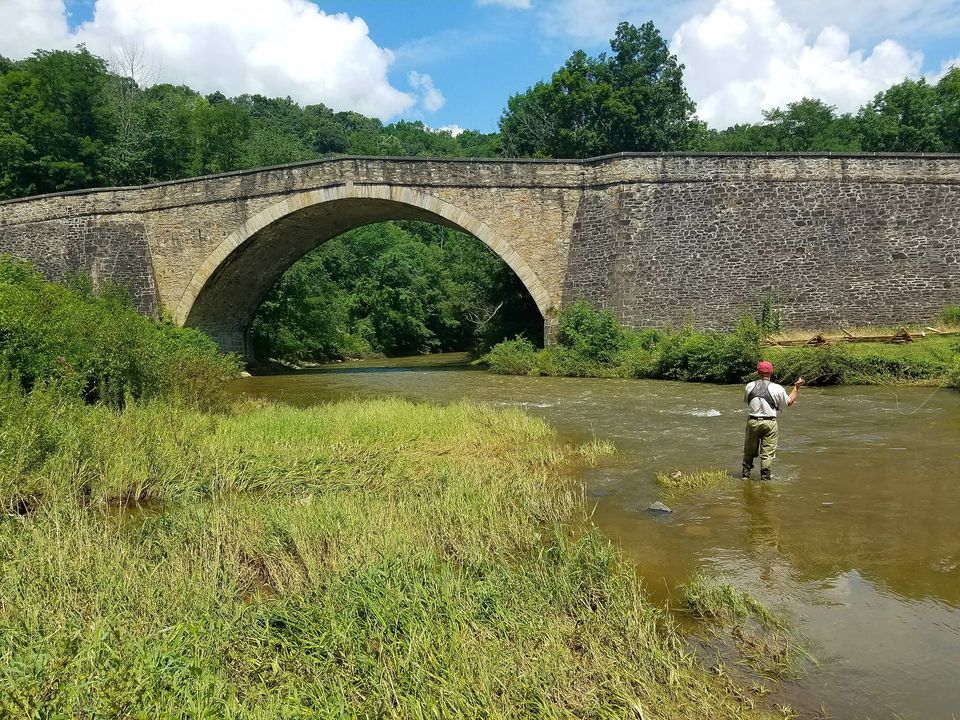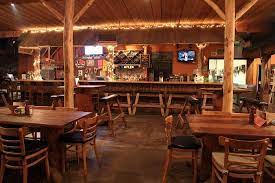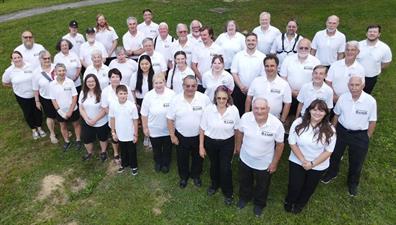Tag: garrett county
This Unique Treehouse Rental is Hidden Away in McHenry, Maryland
Take your getaway to new heights — quite literally — when you book a stay at this picture-perfect treehouse Airbnb near Deep Creek Lake.
Written by
Beth Copenhaver
There's something inherently magical about a treehouse. It harkens back to childhood days and imaginative escapes. If you're looking for a getaway that comes with a heavy dose of whimsy and nostalgia, we invite you to explore Maryland's very own Whispering Woods, a multi-level treehouse hidden away near Deep Creek Lake in McHenry, Maryland. It's a stunning, newly-built cabin wholly enveloped in the woods, offering guests an immersive, secluded stay.
One of the best parts about taking a vacation is the change in scenery. And nothing switches it up quite like sleeping among the treetops. Whether you're a Maryland resident or visiting from out of state, you'll love the chance to move into a real-life treehouse for a few nights. The cabin can comfortably accommodate up to five guests with two bedrooms, three beds, and two baths.
Unlike many treehouse designs, where the space is tight and rustic, Whispering Woods is luxurious. Take some time to explore the interior, and you'll fall in love with the warm wood paneling and ceiling, luxe finishes, and beautiful spiral staircase leading to the second floor. Other top-notch amenities include a fully-stocked kitchen, a living room with a 65-inch TV, and plenty of room to lounge.
One of my favorite features is the use of natural light. Abundant windows offer glimpses of the surrounding trees, and the mountains are also visible in the winter. You'll be staying just a short drive from Maryland's famous Wisp Resort, which offers outdoor activities like skiing and adventure courses year-round.
While the interior is impressive, the outdoor space really sets this place apart from other cabin rentals in the area. Spacious decks, ample seating, and a private hot tub mean you can enjoy being outside even in the middle of winter.
After a day filled with enjoying all that this treehouse has to offer, gather with your crew around the fire pit and enjoy quality conversation under a blanket of stars. It just doesn't get much better! We'll leave you with one recent glowing review that summarizes this stay's many charms: "We had such a great stay here at Whispering Woods! Check-in was easy, everything was super clean, and the house was exactly as pictured. It was very private and peaceful, and we especially loved the cozy loft at the top of the treehouse and using the hot tub every day."
Ready to book your treetop getaway? Visit the official Airbnb page for additional details, including rates, reviews, and reservations.
Looking for even more travel ideas? We've compiled a list of our favorite hotels and resorts in Maryland. We think you'll be packing your bags in no time!
New Germany State Park: Raising Maryland’s Alps
When Western Maryland was a mysterious and distant territory to most Americans, for German immigrants, it felt just like home. Among the villages they settled in, one in present-day Garrett County came to be known nostalgically as New Germany. Today, this village is the location of New Germany State Park. Over a century after its settlement, New Germany hosted the first ski resort south of the Mason-Dixon Line and earned the region the moniker of “Maryland’s Alps.” In between the first German settlers and the ski resort, the land was transformed and made anew. To return to its alpine reputation, New Germany has witnessed the rise and fall of timbering, the growth of scientific forestry, and the snowballing success of outdoor recreation.
When German settlers first arrived in present-day Garrett County, the dense forest seemed like fertile ground for a new start. They were leaving behind war, strife, and their peasant pasts in the old country, where they were subject to feudal obligations. In the eighteenth century, the westward advance of White settlers and the wars they fought against Native American tribes had pushed out much of Western Maryland’s Indigenous occupants. While the German settlers who arrived in New Germany in the 1790s were seeking the opportunity to freely hold land and a reprieve from violence, the Native Americans had faced devastating conflict and dispossession.
The New Germans cleared the land and dammed Poplar Lick Run. By the 1850s, families like the Swaugers, Swartzendrubers, Ottos, and Bittingers had settled around the lake and established a multistory saw and grist mill below the dam. Run by John Swauger, the sawmill harvested the expanses of white pine in New Germany. While most of the New Germans were farmers, by the late nineteenth century they cashed in on the burgeoning timber trade.
View fullsize
The New Germany area as surveyed by the US Geological Survey in 1898, Swauger’s Mill in red, potential locations for the McAndrews Mill in green, Durst and Funk in purple, and Otto’s in teal.
The trees of Western Maryland couldn’t fall fast enough. When transportation lines like the National Road and the Baltimore & Ohio Railroad opened Western Maryland to larger markets, logging companies poured in to harvest the dense forests. Wood supplied housing material, paper, was the dominant source of fuel and heat, and made up the ties of railroads that criss-crossed the nation. Garrett County, once almost entirely forest, saw its trees felled to a point that by 1900, of the forested land not already cleared for farming, eighty-nine percent had been cutover from timbering.
While much of the timberland was in large holdings owned by coal and lumber companies, the New Germans carved out enough of their own plot to form the timbering group McAndrews & Simpson, Christian Otto, Bittinger & Wiley. The men were immigrants or the sons of immigrants and had set up several operations along their local creeks. The introduction of circular steam-powered sawmills, like those produced by H&F Blandy, offered the farmers industrial-style productivity. Swauger’s Mill, running antiquated up-and-down saws, was retired to be solely a gristmill that was later run by Philip McAndrew. McAndrew, the lone Irishman of the group, operated his own sawmill along Elk Lick Run. Christian Otto’s industrial sawmill lay on the edge of his farm on Meadow Mountain. On Poplar Lick Run, a half mile North of the old Swauger Mill were the Funk and Durst Mills, both operating Blandy equipment, and 300 feet apart from each other. These German families may have been cut into the McAndrews, Simpson, Otto, Bittinger, and Wiley operations, or were staking out their own claims in the booming industry.
View fullsize
Ad for a Blandy steam-powered saw mill (Library of Congress)
View fullsize
New Germany is in the quadrant third from the right, and second down, the forested land around the creeks are culled while the ridge timber along Meadow Mountain remains
By 1902 most of the forested land surrounding New Germany had been culled and cutover, and what remained along Meadow Mountain to the east was the most undesirable Ridge Timber (in comparison to the more commerciable Slope and Swamp Timber), a forest type characterized by shallow soil, short trunks, and habitation of fungi and insects. It was during this time, when mountaintops appeared bare and the endless harvest looked near its end, when voices for conservation began gaining ground. At the highest level, Gifford Pinchot of the newly formed US Division of Forestry, was calling for a scientific management of forest resources. His protege, Fred Besley, became Maryland’s first state forester in 1906. Max Rothkugel, another of Pinchot’s colleagues, established one of the first experimental tree plantations of its kind in West Virginia.
View fullsize
Besley’s map of the forests of Garrett County in 1915, the sections marked “c” indicate culled hardwood trees
For foresters like Besley, the treatment of the forest was careless and wasteful. Companies overestimating demand and tanneries who stripped hemlock for its bark left behind large quantities of wood to rot on the forest floor. In New Germany, misplaced white pine logs and stumps laid sunken to the bottom of New Germany Lake. Farmers, especially in Garrett County, cleared land for grazing by burning it. Throughout Maryland forest fires raged, especially in vulnerable cutover lands. Besley advocated for forestry by speaking the language of business, claiming “the present lack of good forest management means a real loss to [Garrett] County of an annual revenue amounting to at least $650,000.” His mission above all was to assign Maryland’s land to “the most profitable uses.”
At first, Besley focused on curbing forest fires and educating landowners on ways to manage and market their timber resources. Less than 3,000 acres of forestland were in state hands in the early 1900s. Yet, Besley’s arguments for conservation failed to sway landowners, and the American economy of unyielding consumption barreled on to the year 1929. The economic collapse and Great Depression that followed gave the government a new mandate for action. The 1929 Federal Utilization Land Program enabled the state to purchase farmland labeled “submarginal” and reconvert it into forest. As a part of the New Deal, the Civilian Conservation Corps (CCC) were put to work, replanting trees, developing recreational facilities, and forming a vanguard of scientific management.
the McAndrews House and (Old Swauger) mill (courtesy Maryland DNR)
View fullsize
The village of New Germany in 1929
The CCC camp below Meadow Mountain (courtesy Maryland DNR)
The act of seizing “submarginal” land was less clean in practice. Not everyone would take a check for the land they had lived and relied on. The farms of more obstinate families would be condemned and they would be evicted. Through this process Maryland acquired 50,000 acres in 1929, including much of the land in and around New Germany. Some parts of the New Germany community survived, including the Otto family, who ran a grocery store, filling station, and farm, and the McAndrews, who came to own much of the land around the lake. New Germany’s one-room schoolhouse remained in use until the 1950s, and still stands today. Otherwise many New Germany farmers were bought out and the land passed into new hands once again to form New Germany Forest Recreation Area (later designated as a state park) and the surrounding Savage River State Forest.
Norway Spruces in rows along New Germany’s Orchard Loop trail
The CCC set up Camp S-52 of Company 326 in New Germany. The young men who joined spent their first winter in tent camps as they built up the infrastructure of the park. They rebuilt the dam and constructed barracks, recreation and mess halls, and cabins out of American chestnut. An early favorite for planting was the Norway Spruce, native to Northern Europe. The CCC also planted Scotch pine and red pine, species native to the Northeastern US, but not Maryland. These species were selected for their ability to repair a damaged landscape, sturdy enough to survive in depleted soil and speedy enough to establish roots that prevented further erosion. Their method for planting was mechanical, girdling old trees to allow younger saplings to take over and arranging the saplings in perfect rows. The New Germany’s CCC camp stood from 1933 until 1938, when some operations moved to Meadow Mountain. CCC work continued in New Germany until 1942.
The ski resort at New Germany emerged from the conservation of the land and the rise of outdoor recreation. In the late nineteenth century, Western Maryland had seen the development of resorts like Deer Park Hotel in Garrett County as getaway locations for wealthy city folk. The sentiment came from a Progressive Era belief in the outdoors as an important site for improved health and leisure. For urban reformers pushing for more park space, the development of recreation spaces was crucial for people of all classes. Fred Besley tapped into these rising currents and developed state forests as state parks in order to secure more funding for forestry.
With its vacation resorts and a new system of parks set up by the CCC, Garrett County earned its reputation as a summer getaway. Yet in the late 30s, ski clubs from Cumberland, Baltimore, and Washington, DC were begging for a resort in the mountains of Western Maryland. Skiing was taking off in the 1930s: the invention of rope-tows in 1932 meant skiers wouldn’t have to climb up mountains to ski down them and the 1936 Winter Olympics had debuted an alpine skiing event. Maryland state foresters Henry Buckingham, Matthew Martin, and Joe Davis set out to make New Germany that resort. CCC members, National Youth Administration crews (another New Deal work program), and Washington Ski Club volunteers constructed the trails. As Maryland’s first ski resort, New Germany opened in 1940. By the mid-50s, the region’s first commercial ski resort had opened in nearby Canaan Valley, West Virginia.
View fullsize
Before New Germany Road (in red), some ski slopes cut down Meadow Mountain towards Poplar Lick Run and the lake
View fullsize
Tow rope on the Otto Farm (courtesy Maryland DNR)
Samuel Otto, son of Christian Otto, lent a portion of his property on Meadow Mountain for a downhill slalom course and beginner trails, while other slopes were built on McAndrew’s Hill, across the lake from Meadow Mountain. On the Otto Farm, the State set up a rope tow powered by a pickup truck while a car shuttle serviced another trail. New Germany exploded in popularity as its cabins were regularly booked through the winter. This never dissuaded avid skiers who would pile on the floor of the Martin House (now Cabin #11) in sleeping bags. City skiers from Baltimore and Washington, DC frequented the New Germany slopes. Young locals made do without the fancy skiers of the more affluent. A descendant of the Swaugers, who worked as a CCC carpenter and barber, created skis out of the hickory bows that came off of CCC trucks.
Skiing at New Germany, February 1941 (courtesy Maryland DNR)
Dorothy Moore, overnight sleeping bag, Feb 22, 1941
New Germany even hosted international meets. Scandinavian and German professionals came to these Maryland Alps. Skiing was a highly celebrated sport in Germany. Perhaps for these skiers the landscape seemed as familiar as it had been to the New Germans and maybe even more so with the CCC-planted Norway spruces native to their homelands. By one way or another, German culture seems to have persevered in New Germany.
The forests of New Germany have seen many changes. From their initial proliferation, to their widespread cutting and clearing, and then their resurgence. The scientific management employed by the CCC focused on the regrowth of timber and planted non-native trees for their speed and stability. The Maryland Parks Service has focused on maintaining the ecology of Western Maryland. They currently foster native species and promote biodiversity by replanting red spruces and eastern hemlocks. While the woods have reclaimed New Germany’s downhill slopes and the ski resort no longer exists, you can still tour the park on skis, via their expanded cross-country trails. Once an Alps-like getaway for city folk, New Germany has earned a new reputation as a local gem and “Maryland’s Best Kept Secret.”
Cross-country skiers atop a frozen New Germany Lake
References
Bailey, Robert. Maryland’s Forests and Parks: A Century of Progress. Charleston, SC: Arcadia Publishing, 2006.
Besley, F.W. The Forests of Maryland. Annapolis, MD: Press of the Advertiser-Republican, 1916.
Blank, Gary. “Forest Management History in the Central Appalachians 1900 to 2000.” Maryland Department of Natural Resources.
Cathell, David. “Garrett County Logging and Mining Railroads.” https://davecathell.tripod.com/garloco.html#clark.
“The Civilian Conservation Corps Part II: A Maryland Perspective.” Maryland Department of Natural Resources, https://dnr.maryland.gov/centennial/Pages/Centennial-Notes/CCC_History_Part_II.aspx.
Curran, H.M. “The Forests of Garrett County,” in Maryland Geological Survey: Garrett County. W. Bullock Clark, Baltimore, MD: Johns Hopkins Press, 1902, 303-329
Durst, Ross. “The Mills of New Germany.” The Glades Star 2, no. 18(1955)
Foxfire 10. eds. George Reynolds et al., New York, NY: Anchor Books, 1993
Hennighausen, L.P. “Early German Settlements in Western Maryland,” in Sixth Annual Report of the Society for the History of the Germans, Baltimore, MD: Schneidereith & Sons, 1892, 13-25
Lund, Morten. “The 1930s: The Unexpected Blossoming of Alpine Skiing.” International Skiing History Association, https://www.skiinghistory.org/gallery/1930s-unexpected-blossoming-alpine-skiing.
Maryland State Archives, “Garrett County Mill Chapter,” https://msa.maryland.gov/megafile/msa/speccol/sc4300/sc4300/000005/000000/000007/unrestricted/garrett%20county%20mill%20chapter.pdf
Nead, Daniel. The Pennsylvania-German in the Settlement of Maryland. Lancaster, PA: The New Era Printing Company, 1913.
“New Germany State Park.” Maryland Department of Natural Resources, https://dnr.maryland.gov/publiclands/Pages/western/NewGermany/Heritage.aspx.
Northeastern Lumber Manufacturers Association, “The Norway Spruce Story.” https://www.nelma.org/the-norway-spruce-story/.
Zumbrun, Francis. “Skiing comes to the ‘Maryland Alps’ in 1940.” Maryland Department of Natural Resources, https://dnr.maryland.gov/centennial/Pages/Centennial-Notes/Skiing-NewGermany.aspx.
Easter at the Airport
The Garrett County Airport is opening its doors for a fun-filled, family-friendly Easter celebration on Saturday, April 12, from 2:00 to 5:00 p.m. This free event, presented in partnership with Taylor-Made Deep Creek Sales, welcomes guests of all ages to enjoy an afternoon of activities, crafts, and sweet treats.
Families can take part in egg coloring with TEAM 1629 Robotics, create paper airplanes from coloring sheets, and snap pictures with the Easter Bunny. Kids will also receive free candy eggs while supplies last. Adding to the excitement, HART for Animals will be on-site with adoptable puppies looking for their forever homes.
The Garrett County Airport invites the community to come out, celebrate the season, and enjoy a unique Easter event in a one-of-a-kind setting.
For more information about the event, please contact Adison Wyer, Garrett County Airport Manager, at 301-746-8599 or awyer@garrettcountymd.gov.
Maryland Sets 51 Youth Fishing Rodeos for 2025
The Southern Maryland Chronicle
ANNAPOLIS, Md. — The Maryland Department of Natural Resources is ready to make waves in 2025, rolling out 51 youth fishing rodeos across the state for kids ages 3 to 15. From the first blooms of spring to the crisp days of late fall, these free events aim to hook young anglers—whether they’re casting their first line or sharpening seasoned skills—in a tradition that’s been reeling in Maryland families for over six decades. Spanning 16 counties, the rodeos promise a blend of excitement, education, and a chance to connect with nature, often set against the backdrop of Maryland’s sprawling State Parks.
This isn’t just about fishing—it’s about legacy. Some of these rodeos trace their roots back to the 1960s, sparked by a vision to give kids a safe space to learn the art of angling while planting seeds of environmental care. Last year, the program drew over 3,300 young participants, a splashy success that’s buoyed DNR’s plans for 2025.
A young angler with his catch during a 2024 youth fishing rodeo near Easton. Maryland DNR photo.
Partnering with dozens of local organizations—from community clubs to park rangers—they’re staging events at ponds, lakes, and streams statewide, backed by the U.S. Fish and Wildlife Service’s Wildlife and Sport Fish Restoration Program. That federal funding keeps the rodeos free, ensuring every kid gets a shot at the water.
Picture this: a sunny morning at Patapsco Valley State Park, a 5-year-old gripping a rod as a sunfish tugs the line, or a 14-year-old at Tuckahoe State Park perfecting a cast under a volunteer’s watchful eye. The rodeos teach more than technique—knots, baiting, patience—they instill a respect for the ecosystems that sustain Maryland’s waterways.
In 2022, DNR stocked over 6,000 hybrid sunfish and trout for these events, per agency records, tipping the odds toward a catch. No license needed for those under 16, though adults and teens can grab one online or at agents, with every dollar fueling conservation efforts like habitat restoration and fish stocking.
The schedule’s a county-by-county haul—Garrett’s mountain streams, Worcester’s coastal flats, and everywhere in between. But some venues cap attendance, so DNR’s nudging families to hit the website, register via listed contacts, and double-check for weather-driven shifts. Last fall’s downpours bumped a few 2024 dates, a heads-up to stay sharp. Events often come with perks—loaner rods, bait, even snacks at spots like Cunningham Falls—making it low-stakes fun with high rewards.
Maryland’s fishing heritage runs deep, from the Chesapeake Bay’s bounty to Deep Creek Lake’s quiet shores. With over 500 miles of fishable streams and countless ponds, per DNR’s maps, the state’s a natural stag
Garrett College spring headcount grows 8%
Number of spring credit students is highest since 2016
McHenry, MD – Garrett College recorded its highest total of spring semester credit students in nine years this semester, according to data released by the College’s Office of Records and Registration (ORR).
GC has 677 credit students this spring, an increase of eight percent, the highest since the College enrolled 693 students in spring 2016. This spring’s enrollment is the second-highest headcount in the last 12 years.
“We’re very pleased to see enrollment continuing to grow,” said Dr. Richard Midcap, Garrett College’s president. “With spring enrollment now finalized, we’ve seen credit enrollment growth for three consecutive fiscal years.”
Total spring credit hours taken by Garrett’s students increased 8.4 percent, rising from 5,650.50 in spring 2024 to 6,126.50 in spring 2025. That’s the highest total since spring 2020, when the College logged 6,190.75 spring credit hours.
The College’s headcount enrollment has grown 28.7 percent over the last four years, according to ORR data. GC’s spring credit hours increased 23 percent over the same four-year time period.
“Our student headcount is almost 12 percent higher than spring 2020, which was our last pre-COVID semester,” said Dr. Robert “JR” Kerns, GC’s dean of student affairs. “That’s really quite an achievement.”
Kerns said new academic programs, including sport management, and expansion of the College’s intercollegiate athletic program have both played roles in GC’s enrollment growth.
“We’ve been intentionally trying to expand opportunities that provide enrollment growth potential,” said Kerns, adding he expects the radiologic technology program that launches in June and the men’s soccer program that starts in August to further expand enrollment.
Ongoing increases in the number of High School Dual Enrollment (HSDE) students is helping to drive headcount increases, according to Dr. Kelli Sisler, GC’s director of institutional effectiveness.
“HSDE grew almost 15 percent from last spring to this spring,” said Sisler, noting that the Garrett College Scholarship Program continues to fund HSDE. “The five-year trend data is even more impressive – there has been an 85 percent increase in the number of HSDE participants this spring compared to spring 2020.”
Professor Christa Bowser, GC’s chief academic officer, said implementation of The Blueprint for Maryland’s Future by Garrett County Public Schools (GCPS) and Garrett College has played a key role in expanding HSDE.
“The Blueprint emphasizes public schools and colleges working collaboratively to offer high school students a dual enrollment option, which GCPS and the College have worked extensively to provide,” said Bowser. “GCPS and the College already had a close working relationship, but the Blueprint sparked an even higher level of collaboration.”
GC’s part-time student population hit an all-time high this spring with 369 part-time students, which Bowser said is largely due to the increase in HSDE.
Garrett County Chamber Of Commerce What's Happening In Garrett County
Garrett County Chamber of Commerce
March 19 - March 25, 2025 |
 |
 |
March 20 | 5:30 pm - 9:00 pm "Jameson for Your Jigs" Event at Shamrock Whiskey & Cigar Bar624 Humbert School Rd, Rockwood, PA.Enjoy food and drinks from Emerald Isle as Jameson hosts our Irish fest. Sampling & Cocktail Hour begins at 5:30 with Dinner at 6:45pm. Hosted by Shamrock Whiskey & Cigar Bar and Southern Glazers Wine & Spirits.5:30 - 6:30 Irish Whiskey tasting & Cocktail hourEnjoy samples from Jameson, Redbreast, & Green Spot or a Specialty Cocktail created to feature each Irish WhiskeyDinner at 6:45pmIncludes: Irish Pub Salad, Baked Oysters, Braised Beef Short Rib, Plum & Cream CobblerTickets are $75 each which includes dinner, tasting, tax & gratuity.Cash Bar available for anything additional.There will be prizes & giveaways from our Irish Whiskey Sponsors!!Click here for tickets: https://square.link/u/qGmSEO1p |
 |
March 20 | 6:00 pm - 7:00 pm Deep Creek Lake Lecture Series Performing Arts Center at Garrett College, McHenry, MD.Join us for our Deep Creek Lake Lecture Series every Thursday in March 2025, 6pm at the Performing Arts Center at Garrett College. The lecture topics are:-Operation of the Deep Creek Hydroelectric Power Station (Brookfield Renewable)-History of Real Estate around Deep Creek Lake (Karen Myers)-Fishing on and around Deep Creek Lake (TBD)-Wildlife and Habitats of Deep Creek Lake (DNR TBD)Follow us for the exact schedule and more details on each lecture!More info on the Deep Creek Lake Centennial including more events, projects, an interactive timeline and more available at https://dcl100.com/ Free Admission. |
 |
March 20 | 6:00 pm - 8:00 pm Community Pottery ClassDeep Creek Pottery, 1550 Deep Creek Drive, Suites C & D, McHenry, MD.We will offer a series of 5 classes that will include the pinch, coil, slab methods and an introduction to the pottery wheel! Every Thursday evening from 6:00-8:00PM for 5 weeks $200.00 per student includes all glazes and firings! $25.00 registration fee to hold your space! The balance due at the first class! Click on ticket link to pay your registration fee! https://square.link/u/ZpkXCsQg |
 |
March 20 | 6:30 pm - 8:30 pm Team Trivia Mountain State Brewing Company, 6690 Sang Run Rd, McHenry, MD.Team Trivia every Thursday, free to play! Contact information: 301-387-3360. |
 |
March 21 | 6:00 pm Game NightVarious Locations.Join us for Game Night every Friday night at various locations. Starts at 6pmCheck on our Garrett Gamers page on Facebook to see location and information. Free Admission.Contact Information: shepherdDCL@gmail.com. |
 |
March 21 | 4:30 pm - 6:30 pm St. Peter's Fish DinnersSt. Peter the Apostle Catholic Church and Parish Center Hall, 208 S. Fourth St., Oakland, MD.Friday Fish Dinners at St. Peter the Apostle Catholic Parish!Everyone's favorite tradition is back . . . Enjoy a BIG fish dinner with your family and friends at St. Peter's in Oakland, Fridays during Lent (March 7 – April 11). Dine-in and Carry-out meals are available.Prices:$13 adults$6 children (ages 12 and under)$7 fish sandwich onlyMenu and event details can be found at garrettstpeter.com/fishdinners.All are welcome! |
 |
March 23 | 1:00 pm - 3:00 pm Team BingoMountain State Brewing Company, 6690 Sang Run Road, McHenry, MD.Team Bingo every Sunday at 1pm!Contact information: 301-387-3360. |
 |
March 23 | 2:00 pm - 4:00 pm Community Choir Rehearsals ScheduledSt. Mark's Lutheran Church, 2nd Street, Oakland, MD.Community Choir Rehearsals Scheduled.Love to sing? Consider joining the Garrett Choral Society! Spring rehearsal season is underway on Sundays from 2-4pm at St. Mark's Lutheran Church in Oakland. This is our 46th year of presenting vocal music to the community. Feel free to stop by or email garrettchoralsociety@gmail.com for more information. The concert date is May 18 at 3pm in the Performing Arts Center at Garrett College.$20 membership fee. |
 |
March 23 | 4:00 pm California Wine Dinner at Cornucopia146 Casselman Rd, Grantsville, MD.Experience five courses of wines from Gundlach Bunschu led by winemaker Joe Uhr alongside elevated pairings from Chef Martin Galloway, CEC. One of California's oldest wineries, Gundlach Bunschu wines are produced at the prolific intersection of the Sonoma Valley, Carneros, and Napa Valley appellations, and are Regenerative Organic Certified. $125pp plus tax or gratuity, reservations essential with 50% deposit.Visit thecornucopiacafe.com for complete menu details. |
 |
March 24 | 5:00 pm - 6:30 pm "Shamrock Session" Irish Dancing Workshop at Cosmic StudiosCosmic Studios, 221 South Third St., Oakland, MD.Join us for a "Shamrock Session" and learn traditional Irish dancing with Cierra Derato (O'Keefe), a World Championship level Irish dancer, who has competed nationally and internationally over the past twenty plus years. Cierra has performed with renowned names such as Eileen Ivers, O'Malley's March, the Saw Doctors, Lilt, and many more. She's danced at the Kennedy Center, the F. Scott Fitzgerald Theater, and at various Embassy events across Washington, D.C. She brings her love of Irish dance to retirement homes, children's centers, and various other organizations across the DMV. Born into a strong Irish heritage, Cierra loves spreading her passion for Irish dance, culture, and music with audiences around the world. Join us at Cosmic Studios, Monday, March 24th from 5:00 - 6:30 pm for a beginner "Shamrock Session" workshop which will include traditional Irish dance lessons and traditional ceili practice, with drinks and snacks provided for $25! Recommended for ages 12 years and up. |
 |
March 25 | 7:00 pm - 8:30 pm Community Band Rehearsals Open to New MembersPerforming Arts Center at Garrett College, McHenry, MD.It’s Spring rehearsal season for the Garrett Community Concert Band! Weekly rehearsals are in progress for the upcoming concert on Sunday afternoon, April 27. New players, both young and old, are welcome to join the band. Auditions are not required, but experience playing a band instrument is recommended. Practices are held from 7-8:30 pm on Tuesday evenings in the Recital Hall at Garrett College’s Performing Arts Center. Come give us a try! Email garrettconcertband@gmail.com for more information. |
County Commissioners Announce Public Meeting Agenda
Garrett County Government
Board of County Commissioners
Meeting will also be Live Streamed at https://www.facebook.com/garrettcountygovernment/
The Board of County Commissioners may close a portion of this public meeting and move into Executive Session to comply with a specific constitutional, statutory, or judicial requirement that may prevent public disclosure about a particular proceeding or matter.
*To comment on agenda items – please send to @garrettcountymd.gov3:00 Administrative Session
Board Appointments – Garrett County Local Emergency Planning Committee
Backbone Housing, Inc. – Request for Fiscal Year 2026 County Property Tax Abatement
Mr. Null will review a number of administrative and managerial matters under his authority and jurisdiction with the Board of County Commissioners
4:00 Call to Order of Public Session, Invocation, and Pledge of Allegiance
County Administrator – Additions/Deletions to Public Meeting Agenda
Approval of Public, Administrative, and Executive Meeting Minutes 4:05 Recognition: Callis Auto Detailing – 35th Anniversary
4:10 Garrett County Department of Financial Services – Purchasing Division
Bid Awards: Bid #25–0206 Pump Station 1–1 / 2–1
Bid #25–0306 Galvanized Steel Modular Panel Truss4:15 PUBLIC HEARING: Garrett County Department of Community Development & Planning - Garrett County Water & Sewer Master Plan 2014 – Amendment #5 – To Incorporate Critical Infrastructure Improvements
4:25 Public Commentary
ADJOURNMENT OF PUBLIC SESSION4:30 FISCAL YEAR 2026 BUDGET PRESENTATIONS:
Garrett County Community Action Committee, Inc.
Garrett County Chamber of Commerce
Ruth Enlow Library of Garrett County
Public issues or concerns that are to be presented to the Board of Garrett County Commissioners during any Public Meeting should be scheduled with Carol A. Riley–Alexander, Executive Assistant to the Board of County Commissioners/County Administrator. The Board of Garrett County Commissioners’ next scheduled Public Meeting will be on Monday, April 7, 2025 at the Garrett County Courthouse beginning at 4:00 PM.
Wolf Den Run State Park Trail Added to Jeep ‘Badge of Honor’ Program
Maryland Department Of Natural Resources
An off-highway vehicle trail at Wolf Den Run State Park is now part of the Jeep Badge of Honor trail program. The Jeep brand announced the designation on Feb. 28, along with designations for trails in Minnesota and Washington. There are 61 Badge of Honor trails nationwide.
When a driver takes on the adventure of completing a trail, they are rewarded with a badge through the program, which they can proudly display on their vehicle. For adventure-seekers, these badges mark achievements they can trace throughout the U.S.
“Owner feedback is essential at the Jeep brand, and Trail 2103 was one of the most highly requested. We’re excited to finally bring it to life. With no previous trails in Maryland, this addition helps us achieve our goal of ‘spreading the love’ by filling in geographical gaps and offering new adventures to our Jeep community in every corner of the country,” said Joe Brungardt, manager, Jeep Badge of Honor program.
Located in the Potomac River Area of the park, Trail 2103 follows the north branch of the Potomac River through the rocky forest. Maryland Off-Highway Vehicle Alliance Board Member Ken Kyler nominated Trail 2103 through Jeep’s Badge of Honor phone app, and thinks the trail was selected because it has amazing views of the Potomac River. There are more challenging trails at Wolf Den Run, but none with such scenery.
“Particularly in the springtime when the rhododendrons and dogwoods are out, it’s just a flat-out gorgeous trail,” Kyler said.
Kyler encouraged other off-road enthusiasts to nominate the trail, including those from the Capitol Off-Road Enthusiasts (CORE 4×4).
CORE 4×4 President Jendra Rambharos said his organization has hosted events at Wolf Den Run since the park’s opening in 2019. These trips include camping, eating at local restaurants and using local repair shops.
“The proximity to Deep Creek, and the amenities there are also a draw for us, as we’ve visited, stayed at, and even fished in the area, adding to both public and private resources through amenities and licensing,” Rambharos said.
DNR worked with Jeep to get the information submitted for the recognition.
“We want to thank the community for nominating our trail for this prestigious program – it shows off-highway recreation is gaining traction here in Maryland and provides another way to get people connected to the land as well as provides an important economic impact to the nearby community,” Maryland Office of Outdoor Recreation Director Sandi Olek said.
Park Manager Donald Oates said there are unique rock outcroppings along the trail. The area has rugged and mountainous terrain, with meadows, wetlands, small tributaries and many ephemeral streams throughout. Drivers may encounter the occasional water feature depending on the time of year.
Trail 2103 isn’t the only fun OHV trail at Wolf Den – there are more than 50 miles of trails to check out. Campsites are also available.
“We have miles and miles of trails that are good for Jeeps,” Oates said.
Most off-road trails at Wolf Den Run are former mining or logging roads, with plenty of space for larger vehicles like Jeeps. Trail 2103 can be made into a loop using trails 2104 and 2101. A map of Trail 2103 and adjoining trails can be found on the Wolf Den Run State Park website.
There are no air compressors available at the park, so drivers need to plan accordingly and be prepared.
Wolf Den Run State Park opened in 2019, the first park in the state to offer trails for off-road vehicles. Maryland Park Service expanded Wolf Den Run in 2020.
Before the park opened, Off-Highway Vehicle Alliance Board volunteers spent a day clearing appliances and other large debris from the site. The Alliance and DNR work together to promote environmental stewardship when riding. ATV
Riders can recreate responsibly by staying on designated trails, respecting wildlife, and being considerate of other trail users. In addition, riders can practice good stewardship by avoiding muddy areas, crossing streams at a 90-degree angle, using four-wheel low and first gear for engine braking, and going over obstacles like rocks rather than around them to prevent trail widening and erosion.
Garrett County Progress in Motion Updates on Local Business, Jobs, and Community Growth
A Message from Steve Kelley:
Reflecting on Progress: Key Economic Wins in 2024 and Our 2025 Future
As 2024 is behind us, it’s clear—Garrett County is on the move. The past year has been a testament to the power of smart investment, community-driven growth, and the tenacity of our local businesses. We’ve made real progress, setting the stage for an even stronger 2025.
Our focus has always been on making Garrett County the best place for families to live, work, and thrive. This year, we’ve doubled down on infrastructure, housing, business expansion, and healthcare—laying a solid foundation for sustainable growth. Thanks to the tireless efforts of our community development team and the support of local leaders, we’re not just keeping up—we’re winning.
Economic success doesn’t happen in a vacuum. It happens because of the hardworking, determined people who call Garrett County home. The grit and perseverance of our homegrown businesses have fueled organic growth, proving that our strongest asset is our community itself. With their relentless drive, we are leading the way.
Major Investments That Are Shaping Our Future
Housing & Community Growth
· North Hill Community – $900,000 from the Senator George Edwards Economic Development Fund for infrastructure supporting 126 senior housing units (55+).
· Town of Accident – Flat Street – $435,000 from the Senator George Edwards Economic Development Fund for infrastructure, creating 10 new residential building lots.
· Springs Housing (Hemlock Grove) – $1,200,000 from the Senator George Edwards Economic Development Fund for infrastructure in Grantsville, adding approximately 60 single-family homes priced at $200,000–$250,000.
· Cherry Hill – $1,000,000 from the Senator George Edwards Economic Development Fund to develop a 24-bed assisted living facility in Oakland/Mountain Lake Park.
Healthcare & Community Services Expansion
· Mountain Laurel Medical Center – $1,000,000 from the Senator George Edwards Economic Development Fund for expansion and remodeling in Grantsville, adding a pharmacy, imaging center, and exam rooms.
· Quest for Hope – $167,455 from the Senator George Edwards Economic Development Fund to remodel a new counseling facility in Grantsville, providing critical mental health support for the community.
Business & Industrial Park Development
Keyser’s Ridge Business Park
· New Facility – 15 acres under contract (NDA in place) with an estimated creation of 25+ jobs.
· Shell Building – Daystar Construction will build a 50,000 sq. ft. facility to market for sale or lease.
· Centralized Propane Facility – Providing metered propane service to tenants, a necessity since natural gas is not an option at this location.
· Access Road – Set for completion in 2025, opening several new lots for development.
Southern Garrett Business & Technology Park
· Sunrise Sanitation – Purchasing Lot 9 to relocate from West Virginia, creating 26 new full-time jobs and expanding waste collection and recycling services.
McHenry Business Park
· CannaBarons – Purchasing the Medco building, with an estimated addition of 40–60 full-time jobs.
· Hannick Homes – Under contract for a new office building, expanding local business presence.
Francis Sanders Drive
· CHIPS Properties – Purchasing two acres for a new office and warehouse, expanding operations due to new contracts in West Virginia.
Renewable Energy & Solar Development
Garrett County is solidifying its role as a leader in renewable energy with two massive solar projects:
· Backbone Solar – 900 acres currently under construction.
· Jade Meadow – 1,000 acres scheduled to begin development in 2026.
Once completed, Garrett County will host the two largest solar projects in Maryland. Meanwhile, we continue to receive a flood of community solar project requests each week, further emphasizing our region’s attractiveness for clean energy investment.
Parks & Trails Expansion
Through numerous grants and partnerships, Siera Wigfield continues to expand and enhance our parks and trails, moving closer to a long-term vision of connecting our communities through an integrated trail system. These efforts will provide increased recreational opportunities, boost tourism, and improve overall quality of life.
Airport Development & Expansion
The Garrett County Airport continues to grow as a key economic asset, supporting both tourism and business operations. The airport provides small freight and ground support services for commercial and general aviation, enhancing its role in regional economic development.
Adison Wyer is the new Airport Manager.
· Tourism Expansion – Contract in place to allow a local pilot to offer bi-plane tours.
· New Hangars – Leasing more ground for additional hangars on the west apron, with the potential for eight box hangars for businesses or individuals.
· McHenry Business Park Access – Working with the FAA and MAA to construct a new access road to open additional development opportunities.
· Monthly Rentals: Several “T” hangars are available for pilots
· Opportunities: Option to construct up to 8 box hangars for interested businesses or individuals.
Holding Our Own & Leading the Way
In a state struggling to keep up with the economic trends shaping our region and the nation, Garrett County is holding its own—and then some. From housing to business expansion, renewable energy to aviation, our county continues to make the right moves, proving that smart investments and a strong community can drive lasting success.
Lastly, note a key driver of our business development success is our dedicated team. Kim Durst, Manager of Business Development, brings invaluable expertise, while Connor Norman, Business Development Specialist, takes a hands-on approach to business engagement. Together, they ensure our local businesses have the support, resources, and connections needed to grow and thrive.
With momentum on our side, we’re ready for an even bigger 2025.
Created 3/14/2025 12:33pm
Last Updated 3/14/2025 12:38pm

203 South Fourth Street, Oakland, Maryland 21550
Phone: 301-334-1921
Ruth Enlow
The Ruth Enlow Library of Garrett County serves the community with five branches:
Oakland (Main): 6 North Second Street, Oakland, MD 21550
Accident: 106 South North Street, Accident, MD
Friendsville: 315 Chestnut Street, Friendsville, MD
Grantsville: 102 Parkside Drive, Grantsville, MD
Kitzmiller: 288 West Main Street, Kitzmiller, MD
Each branch offers a variety of resources, including books, online materials, DVDs, and diverse programs for all ages. For more information on operating hours, events, and services, please visit their official website:
RELIB.NET









